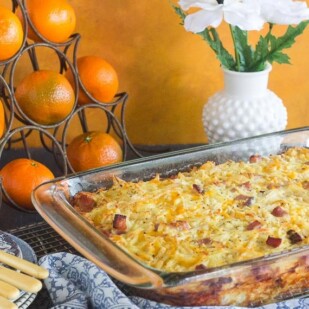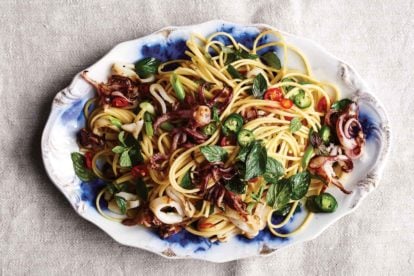Sausages Come in Many Shapes and Sizes
They are not always stuffed into casings forming the classic “hot dog” shape. Breakfast Sausage is usually patty-style and this means that they are no more difficult to make than a hamburger. Never thought you could make sausages?
Yes, you can! And they can be low FODMAP, too.
These Breakfast Sausage Patties combine ground pork with all the expected sausage flavors like sage, thyme and fennel.

Don’t Leave the Fennel Seed Out
It is that iconic, faintly licorice-y flavor in sausage that really makes a difference. The brown sugar lends sweetness and encourages a nice caramelizing when they hit the pan and the red pepper flakes balance it all out.
Crushing the fennel seeds can be a challenge as they tend to roll around your work surface. Sometimes we chop them – gently so they don’t fly around – and sometimes we use the broad side of a heavy chef’s knife to crush them.
Our favorite is our mortar and pestle – your choice.
For a pork chop dish you might like, check out our low FODMAP brined version.

Low FODMAP Breakfast Pork Sausage Patties
These breakfast sausages are as easy to make as mini burgers! The freeze well, too.
Low FODMAP Serving Size Info: Makes 8 patties; serving size 1 patty
Ingredients:
- 1 tablespoon firmly packed light brown sugar
- 1 tablespoon finely chopped fresh sage or 1 teaspoon rubbed (ground) sage
- 1 tablespoon finely chopped fresh thyme or 1 teaspoon dried thyme
- 11/4 teaspoons kosher salt
- 1 teaspoon crushed fennel seeds
- ½ teaspoon chilli powder, such as ground red serrano chilli
- ¼ teaspoon paprika
- Freshly ground black pepper
- 1 pound (455 g) ground pork
Preparation:
-
Place brown sugar, sage, thyme, salt, fennel seeds, chilli and paprika in a medium sized mixing bowl. Add a generous amount of black pepper. Use your fingers to rub the mixture together to make sure all the herbs and spices are well mixed. Add the pork and mix everything together well. (This mixture can be made the night ahead, if you are planning a big morning. Just cover the bowl with plastic wrap).
-
Use a 1/4-cup (60 ml) measuring cup or similar sized ice cream scoop to create patties, flattened to about 1/4-inch (6 mm) thick. They will expand in thickness upon cooking.
-
Heat a cast iron or heavy skillet over medium-high heat. Cook patties for about 2 to 3 minutes or until golden brown on bottom, flip and cook second side until golden. The patties should be cooked through.
-
Sausages are ready to serve. They may also be frozen: cool first, stack in single layers separated by parchment paper in an airtight container and freeze for up to 1 month. You can heat them stovetop in a pan or in the microwave.
Notes:
Tips
- Want a lighter version? Use half ground turkey and half ground pork. You still need a good quantity of pork to get that sausage taste and texture.
-
We like these made with either smoked paprika or sweet paprika.
Nutrition
All nutritional information is based on third-party calculations and should be considered estimates. Actual nutritional content will vary with brands used, measuring methods, portion sizes and more. For a more detailed explanation, please read our article Understanding The Nutrition Panel Within Our Recipes.








These are honestly the best breakfast sausage patties I’ve ever made, both my husband and I were just raving about how flavorful they are. Thank you for sharing this keeper of a recipe!
Hi Emily, Thank you so much for letting us know! I haven’t made them in a while and now you have inspired me! Have you tried freezing them? It works quite well and makes it so easy for subsequent meals.
That’s a great idea as we did contemplate making a double batch the second time around, we’ll definitely try freezing them, thanks for the tip!
Looks delicious!!! Thanks for sharing. Another yummy recipe added to my low fodmap breakfast list. 🙂
Make a bunch and freeze the patties. They defrost quickly and you can have them at a moment’s notice!
This sausage is SO good!! The flavor is spot on & they cook up beautifully. I’ve tried others & they missed it on flavor. I don’t use as much brown sugar & omit pepper due to food sensitivity, and still yet the flavor is just great! Thank you so very much for this recipe!
Oh Sue, Thank you so much for letting us know! Enjoy!
I just made these for dinner tonight, and Oh. My. Goodness. They’re delicious! Thank you so much for this recipe. I’m just starting out with a low fodmap lifestyle, and so many of my favorite foods are on the list of high fodmap foods. So finding these garlic-and-onion free sausages is like a godsend. I’m definitely printing this page for my low-fodmap recipe file. Tonight’s dinner was the best I’ve had in a long time. Thank you again. And thank you for this fabulous, extremely helpful website. I visit often. And I’ll be back for more!
Jodi, what a LOVELY note! This made our day. THIS is why we keep at it! We want everyone to know that they can THRIVE on the low FODMAP diet. Feedback like this is so wonderful.Thank you. Enjoy our recipes!